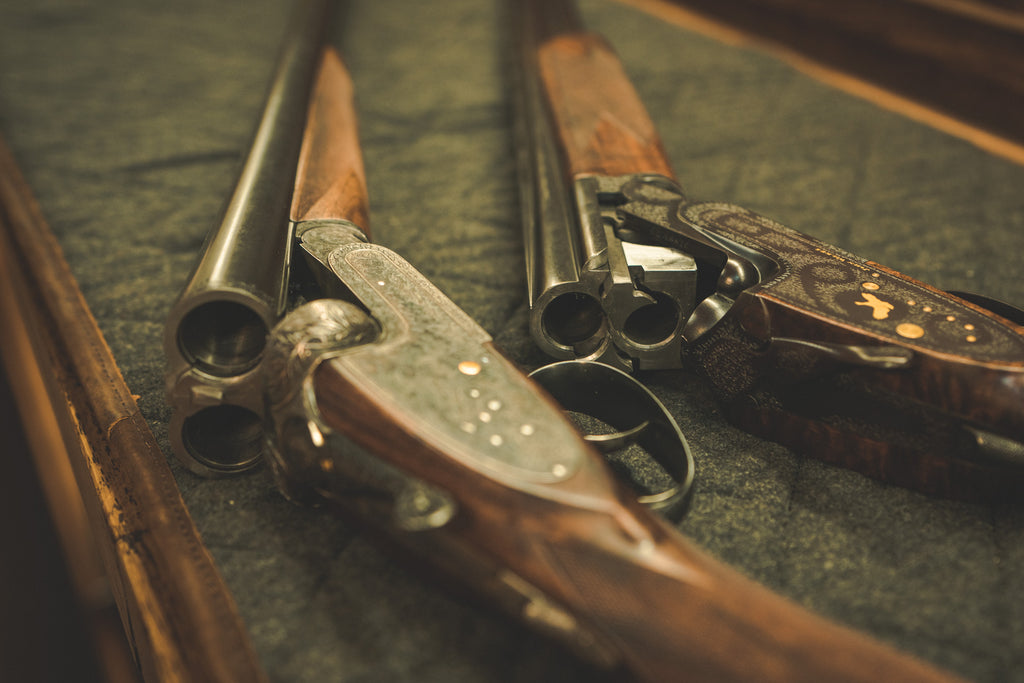Extractors & Ejectors: What You Need to Know

In the world of double shotguns, there are two main types; Extractor and Ejector guns. There are pros and cons to each but both have their place and can provide their own advantages in the field. So which is best for you?
History
To better understand extractors and ejectors you need to take a look into the history of them. With the advent of the metallic cartridge many new innovations happened. Old muzzleloading firearms became virtually obsolete overnight as self contained cartridges could be reloaded faster making them a more effective option.
New breechloading firearms flooded the market, everything from brand new designs to muzzleloader conversions. These new cartridges brought on a multitude of ways for the shooter to remove or extract the fired case. Hence the name, "Extractor." A very early example of an extractor is the manually operated one on the Ballard Rifle. The lever on the bottom of the forearm is manually pulled rearward removing the case. Almost immediately designers figured out how to use mechanical advantage to give them an edge, making it extract on its own through the normal operation of opening the action.

Ejectors followed soon thereafter. In 1874, J. Needham produced a side by side shotgun design that incorporated ejectors. This design had separate extractors for each barrel. If a barrel was not fired, the extractors would raise the cartridge out of the barrel just enough to be grabbed by the user. If it were fired, the empty would be thrown clear of the gun. Only the barrel that was fired would eject the shells, allowing for a quick reload in a hunting situation. This set the precedence for what an Ejector gun was to become.
Many variations of ejectors exist today, in W.W. Greener's book, The Gun and its Development he lists more than fifteen unique designs for ejector mechanisms and that book was published in 1910. Ejector guns caught on like wildfire. However, extractor guns remained popular due to their simplicity and durability, they are still very popular today.
Extractor Guns
By definition, the extractor is the component within a firearm that aids in the removal of the cartridge from the chamber. With the exception of a few blowback operated designs, they exist in almost every modern firearm.
In extractor shotguns the extractor does all the lifting of the shotgun shell. When the gun is opened, it is using the mechanical advantage of the barrels hinging open to raise the extractors, and bring the shell just high enough for you to be able to remove it manually.
The easiest way to identify an extractor gun is by opening the firearm and looking for the one piece or solid extractor as seen on this CZ Bobwhite. On ejector guns, this part will usually be split in half, referred to as "Twin Extractors".

Extractor guns are very durable and consist of very few moving parts. They will last a lifetime if taken care of properly. In the field, they are slower to reload but allow you to have 100% accountability of your shotgun hulls.
Ejector Guns
The ejector is the device that throws the empty cartridge case clear of the breech. Ejectors can be hard to identify in a break open shotgun without firing or disassembling. The confusing thing about them is that in firearms other than double guns, the ejector can be identified as one or two parts. On double guns, "ejector" is referring to a whole system, meaning there isn't just one part you can point to and identify as "the ejector".
Ejector guns have extractors. Yep, you read that right. The extractor in an ejector gun works the same way as in an extractor gun, until the gun is fired. The mechanical act of firing the gun trips the spring loaded ejector mechanism located inside the forearm. So that when it is opened, it shoots the empty(s) out. They are designed to only eject on the fired barrel, and extract on the unfired barrel, preventing you from ejecting live cartridges onto the ground.
These mechanisms can be very complex. I've worked on old English ejector guns that functioned flawlessly using dummy ammo, yet wouldn't work at all firing live rounds. The problem? The dummy ammo's primer allowed the hammer to travel a little more than the live primer. That extra few thousandths of travel would trip the ejectors properly. These can be very complicated systems!

Ejector guns tend to be more expensive because of the extra time and money involved in making them. They allow for much quicker reloads in the field and are truly works of art. However, they can be finicky from time to time and when issues occur the gunsmith fee can be steep due to the complexities involved. Some ejector guns have a selector to turn them into extractor guns when preferred, giving you the best of both worlds.
Function Check: Are they working properly?
Checking the function of the extractors and ejectors on a firearm is a critical component if looking at buying a used shotgun or doing an annual check up on your upland gun. If they are not working properly it can lead to more issues down the road.
Check to see if the extractors are working properly. Simply rotate the top lever and open the action slowly. The extractor should raise from the breech face far enough to allow your fingers to grasp the rim of the shell. At its full movement it will be clear of the top of the receiver. Then close the action slowly. If everything closes smoothly then you are good to go.
If the shotgun has an ejector mechanism you need to do a more thorough check. This involves snap caps and the permission of the owner of the shotgun to dry fire using them. Insert the snap caps and close the action. Pull the front trigger and open the action slowly. The corresponding barrel should eject the shell while the opposing barrel extracts. Repeat the process with the other trigger. Finally, do both triggers, both should eject.
Throughout this process the ejection needs to clear the receiver. This is called ejection timing. If you open the action slowly and the shell ejects out and hits the breech face there is a problem. If it works fine opening faster, this may not be an issue to you. That is up to the buyer at that point.
Extractors or Ejectors? What's Right for You?
Which is better? That is up to the user. There is nothing quite like a finely tuned English ejector gun with craftsmanship rivaling a Swiss watch. But it is far from necessary. All of my double shotguns are extractor guns and I have never wished I had one with ejectors. It is personal preference. With that being said, I hunt with a 1950s Sweet Sixteen Auto 5 and chase my hulls around the plains of Montana after each Sharptail flush. Not convenient but I like it!
In the end nothing beats a good double gun. They are functional works of art, and there are so many different models out there that you can get exactly what you want!
Written by Kurtis Martonik
